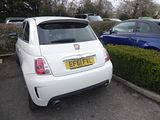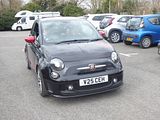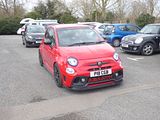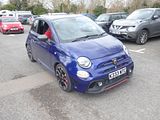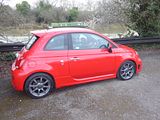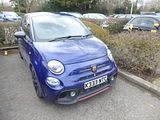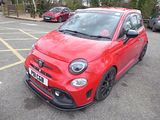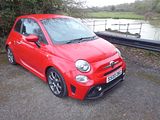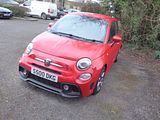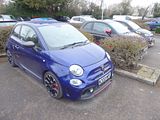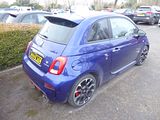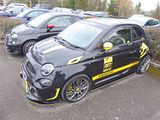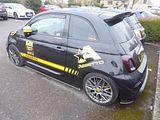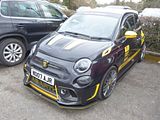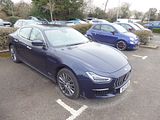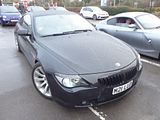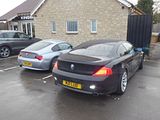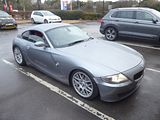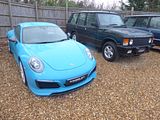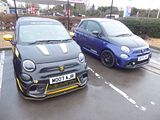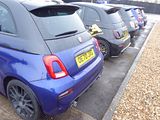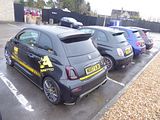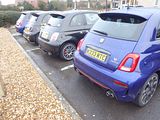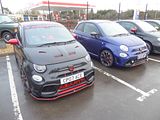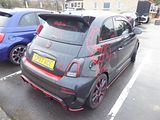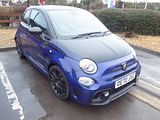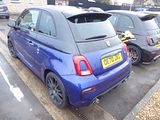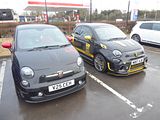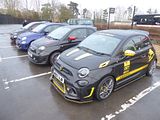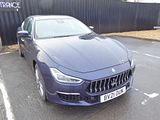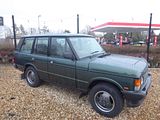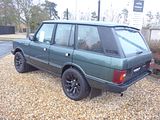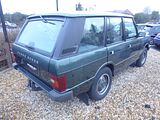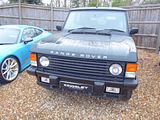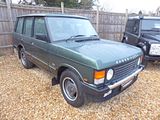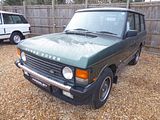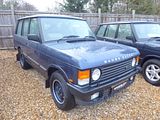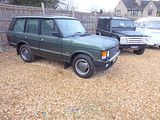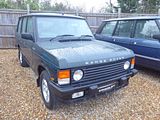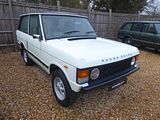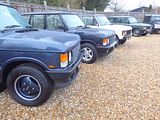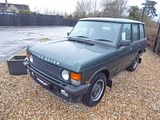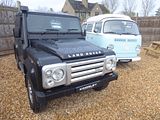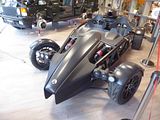bIt is generally the case that any venue at which it is hard to get a booking is worth persevering with, as there is a good reason why it is popular. So, when the idea was created in the Abarth BOL (Bucks, Oxfordshire and London Group for another of those low season events where meeting up for food would be more the focus of the day than just staring at cars at the venue, then it proved necessary to go for a very late lunch, with a table booking at the Trout Inn only available from 2:30pm. We were all assured that it would be worth it, though, and as the diary was free, I booked up to go along. The Trout is situated on the banks of the upper reaches of the Thames, in the pretty Oxfordshire village of Wolvercote, which is located just a couple of miles off the A34, to the north of Oxford. You can certainly see why this would be an extremely popular location in the summer months, as there are extensive pub gardens, but even in the winter season, it is popular, having built up an enviable reputation for the quality of its food as well all the other aspects which make a village pub so appealing. Here are the photos from a day which started off as I expected, but which took a twist and an added location, conceived in real time whilst we were eating.
TROUT INN
On arrival, the main car park was pretty full, so it was very much a case of parking wherever there happened to be a free space. But as we were waiting for everyone to arrive, quite a few people who had clearly finished their lunches returned to their cars and pulled out, leaving a few spaces that were next to each other, so we were able to get some, but not all of the cars parked together in one group.
All the Abarths here were the 500-based models which have been on sale now since the end of 2008, following a launch at the Paris Show that year. Since that time there have been a number of detailed changes to the standard cars and a lot of limited editions. Those who really know the marque can spot most of them, but some are so subtle that unless there is a badge you can see, you will not ne quite sure which version you are looking at. It used to be relatively easy, when the model was first launched, as there was only one version as shipped ex works called the 500. It had a 135 bhp 1.4 litre turbo-charged engine coupled to a five speed manual gearbox, with 16″ alloys as standard, and the option of 17″ wheels, and a colour palette comprising of two whites (BossaNova White, the standard colour, or the pearlescent Funk White), Red (Pasadoble), Pale Grey (Campovolo) or Black. If you wanted more power – 160 bhp – then you could order an Esseesse kit, which came in a large wooden crate, containing new wheels, springs, an ECU upgrade, the Monza exhaust system and badging. It was dealer fitted and could be applied at any time within the first 12 months or 10,000 miles from registration. Needless to say, it proved popular. As were many of the optional extras, with stickers for the sides, a large scorpion for the bonnet and even a chequered pattern for the roof among the personalisation options offered. Sales of these cars were steady but not in what you would call quantity, and anyway, it is quite a long time ago, so it is perhaps a surprise there were two of them here.
The Series 4 version of the familiar 595 first reached the markets in the middle of 2016. After rumours had circulated all winter following the launch of the facelifted Fiat 500 in 2015, Abarth finally unveiled the Series 4 at the end of May 2016. Initially, we were told that the cars would not be available in the UK until September, but that came forward somewhat, with dealers all receiving demo cars in June, and the first customers taking delivery in July. Three regular production versions of both the closed car and the open-topped C were initially available, all badged 595, and called Custom, Turismo and Competizione, as before, though numerous limited edition models have since appeared and in most case disappeared. The most significant changes with the Series 4 are visual, with a couple of new colours, including the much asked for Modena Yellow and a different red, called Abarth Red, which replaces both the non-metallic Officina and – slightly surprisingly – the tri-coat pearlescent Cordolo Red. as well as styling changes front and rear. The jury is still out on these, with many, me included, remaining to be convinced. At the front, the new air intake does apparently allow around 15 – 20 % more air in and out, which will be welcome, as these cars do generate quite a lot of heat under the bonnet. Competizione models for the UK retain the old style headlights, as they have Xenon lights as standard, whereas the Custom and Turismo cars have reshaped units. At the back, there are new light clusters and a new rear bumper and diffuser. Inside, the most notable change is the replacement of the Blue & Me system with a more modern uConnect Audio set up, which brings a new colour screen to the dash. Mechanically, there is an additional 5 bhp on the Custom (now 145) and Turismo (now 165 bhp) and the option of a Limited Slip Diff for the Competizione, which is likely to prove a popular option. Details of the interior trim have changed, with a filled-in glovebox like the US market cars have always had, and electric windows switches that are like the US ones, as well as a part Alcantara trim to the steering wheel in Competizione cars.
One of two limited production (or Collector Edition, as Abarth have called them) cars released in September of 2020, the 695 Monster Energy Yamaha Edition was the cheaper of the pair.. It was inspired by the MotoGP superbike, while the more expensive Scorpioneoro that was released at the same time was designed, so we are told. Based on the 165 bhp Turismo and like the Scorpioneoro, this limited-edition car gets new Abarth sports seats, albeit with blue finishes and the ‘Monster Energy Yamaha MotoGP’ logo on the head restraints. The blue lining contrasts with the black dashboard, while the numbered plate denoting the car’s special-edition status is placed on the central tunnel. Other features include the flat-bottomed steering wheel, sport button and the Record Monza exhaust with active valve. There’s a specially designed braking system, too, which complements the Koni rear suspension. That itself is fitted with Frequency Selective Damping (FSD) technology designed to improve the ride and handling characteristics of the car. 2000 were produced globally.
Many owners modify their cars, and the results are generally unique, with any visual changes making the cars particularly distinctive. These then become well known in the community and a couple of well known cars were here: the yellow detailing on Mark Rosales’ car has seen further additions over time as he seeks to make more changes; Chris Parmenter’s (known as Bella l’Abarth in the community) is also based on a black 595, but he has used red as his colour contrast.
Logistics reasons meant that I came not in my Abarth but the Ghibli.
KINGSLEY CAFÉ
And so to the second part of the day. This came about as event organiser had somehow gone straight past the Trout Inn and got all the way to the Classic Motor Hub in Bibury before realising that he had completely goofed it and gone to the wrong place. As he was driving back along the A40, he passed a location just outside Witney with lots and lots of cars parked up, clearly some sort of event taking place. He made an about-turn and went to investigate and found this was a place called Kingsley Café, and yes they had been hosting a breakfast club meeting which was just ending, but the venue itself would be open for the rest of the day. On site is a café which only opened around 4 weeks prior, and so is still getting properly set-up. We decided to go along as group to investigate further.
When we arrived, most of the cars that had apparently been there earlier in the day were gone, and there were just a few that worthy of photos in the car park but needless to say I could resist with the camera.
BMW 6 series (E63): The second generation of the BMW 6 Series consists of the BMW E63 (coupe version) and BMW E64 (convertible version) grand tourers. The E63/E64 generation was produced by BMW from 2003 to 2010 and is often collectively referred to as the E63. The E63 uses a shortened version of the E60 5 Series chassis and subsequently shares many features. The car initially drew criticism, due to its controversial styling and complicated iDrive system. The exterior was designed by Adrian van Hooydonk, based on the 1999 BMW Z9 concept car designed by the then BMW Design Chief Chris Bangle. The controversial rear styling, first seen on the E65 7 Series, was nicknamed “Bangle Butt” by critics. BMW described the styling philosophy as “flame surfacing”, where concave and convex shapes meet to create sharp edges. To reduce weight, the doors and bonnet are made of aluminium, and the boot and front wings are made of carbon-reinforced plastic. The kerb weight is 1,490–1,930 kg (3,280–4,250 lb). Coupé models were unveiled at the 2003 Frankfurt Auto Show, and introduced on the market in mid of the 2003 model year. Convertible models were unveiled at the 2004 Detroit Auto Show, and released in mid 2004. Convertible models featured a non-conventional convertible top design with side fins and an integrated wind deflector that can be raised or lowered at any time. The M6 version was initially introduced as a coupé at the 2005 Geneva International Motor Show, and later in convertible form at the British International Motor Show in 2006.The M6 is powered by the 5.0-litre naturally aspirated S85 V10 shared with the E60 M5, generating 500 bhp at 7,750 rpm and 520 Nm (384 lb/ft) at 6,100 rpm. The majority of the cars were produced with a 7-speed automated manual transmission (“SMG III”), however a 6-speed manual transmission was also available in the United States. The M6 coupé has a carbon fibre roof in order to reduce weight and for a lower centre of gravity. Additional features included: sports seats, larger front and rear brakes, an M-performance instrument cluster, a carbon-fibre roof (coupé only), and an optional M head-up Display. The car also has quad exhaust-pipes and larger, more aerodynamic air intakes. A total of 9,087 coupés and 5,065 convertibles were built; amounting to 14,152 cars. In March 2011, the BMW 6 Series (F06/F12/F13) began production as the successor to the E63.
BMW Z4 coupe (E86): This has been offered in three different generations, of which this is the first, consisting of the BMW E85 (roadster version) and BMW E86 (coupe version) sports cars. The E85/E86 generation was produced from 2002 to 2008. The E85/E86 replaced the Z3 and is the third model in the BMW Z Series. Initial models were in the roadster (E85) body style, with the coupé (E86) body style being added in 2006. As per the Z3, the E85/E86 was manufactured solely in Greer, South Carolina. The E85 was designed by Danish BMW-designer Anders Warming from mid-1998 to the summer of 1999. The coupe models were designed by Tomasz Sycha. The E85 designs were frozen on March 1, 2000. The Z4 was introduced at the Paris Motor Show in 2002, and North American models went on sale in November of the same year (as the 2003 model year). European sales began in March 2003. The Z4 Roadster was launched in 2002 with the 2.5i and 3.0i six-cylinder models. Transmission choices were a five-speed manual, six-speed manual, five-speed automatic and a six-speed SMG-II automated manual transmission. A four-cylinder model, the Z4 2.0i Roadster, was introduced for the European market in May 2005. The drag coefficient is maximum of Cd=0.35. BMW unveiled a concept coupé version of the Z4 at the 2005 Frankfurt Motor Show The design of the Z4 and Z4 coupé has variously been ascribed to Anders Warming, Chris Bangle, the controversial former BMW Head of Design, and Adrian van Hooydonk, former BMW chief designer, and BMW designer Tomasz Sycha. The design was approved in Summer of 2004 and frozen in December 2004. The company announced in 2005 that the two-door coupé would be available for production including the return of the M Coupé. The production car was introduced at the New York Auto Show in April 2006 and was available for sale in late May 2006. Thanks to its hatch design, the Z4 Coupé offers 10.1 cu ft (0.29 m3) of trunk space, compared with 8.5 cu ft (0.24 m3) for the roadster. The Coupe’s fixed roof increases torsional rigidity, resulting in a stiffness of 32,000 Nm (24,000 lb/ft) per degree of body twist on the coupe (compared to 14,500 N⋅m (10,700 lb⋅ft) per degree on the roadster), which improves turn-in and overall handling response. The roof has a “double-bubble” contour which serves as an aerodynamic aid and offers more headroom than the roadster with the soft top closed. The Coupé has a sleek fastback rear window that slopes down to an integrated spoiler which is shaped to deliver downforce to the rear axle at high-speed. The model range for the Coupé was more limited than the roadster, and consisted of the six-cylinder 3.0si and Z4 M model only. Transmission choices were a 6-speed manual and a 6-speed automatic with shift paddles mounted on the steering column. In February 2009, the BMW Z4 (E89) began production as the successor to the E85/E86.
Porsche Cayman
VW Golf GTi VII
There was also the opportunity to take some more photos of our cars, of course.
Parked up outside were a whole load of Range Rovers and it was at this point that the name Kingsley started to ring some bells. The business that is based here has been around for some years and has made its name restoring Range Rovers, largely of the first generation. Talking with the staff. They said that there are somewhere between 300 and 500 old Range Rovers on site, in various states from restorable to suitable only for parts, Kingsley will restore your car or create one for you to your spec, and if that means putting a Corvette engine in it, or upgrading the interior to the height of luxury, then they will do it. The results are impressive, but all this does not come cheap, and the prices on some of the cars we saw evidenced that.
The first-generation Range Rover was produced between 1969 and 1996. It was available only in a 2-door body until 1981. (Before then, 4-door models had been produced by specialist firms). Unlike other 4x4s such as the Jeep Wagoneer, the original Range Rover was not designed as a luxury vehicle. It was up-market compared to preceding Land Rover models, but the early Range Rovers had fairly basic, utilitarian, interiors with vinyl seats and plastic dashboards that were designed to be washed down with a hose. Convenience features such as power steering, carpeted floors, air conditioning, cloth/leather seats, and wooden interior trim were fitted later. The Range Rover was a body-on-frame design with a box section ladder type chassis, like the contemporary Series Land Rovers. The Range Rover used coil springs as opposed to leaf springs, permanent four-wheel drive, and four-wheel disc brakes. The Range Rover was originally powered by various Rover V8 engines and diesel engines. Originally, the Range Rover was fitted with a detuned 130 hp version of the Buick-derived Rover V8 engine. In 1984, the engine was fitted with Lucas fuel injection, boosting power to 155 bhp. The 3.5-litre (3,528 cc) engine was bored out to a displacement of 3.9 litres for the 1990 model year, and 4.2-litre in 1992 for the 108-inch Long Wheelbase Vogue LSE (County LWB [long wheelbase] in North America). One of the first significant changes came in 1981, with the introduction of a four-door body. Shortly after twin thermo fan technology was introduced to reduce significant overheating problems 1970s models experienced in Australia. In 1988, LR introduced a 2.4-litre turbodiesel (badged Vogue Turbo D) with 112 bhp, manufactured by Italian VM Motori. The same engine was available in the Rover SD1 passenger car. The diesel project was codenamed project Beaver. During the project, 12 world records were broken, including the fastest diesel off-roader to reach 100 mph (160 km/h), and the furthest a diesel off-roader has travelled in 24 hours. In 1990 project Otter was unveiled. This was a mildly tuned 2.5-litre, 119 bhp version of the ‘Beaver’ 2.4. In 1992, Land Rover finally introduced their own diesel engines in the Range Rover, beginning with the 111 bhp 200TDi, first released in the Land Rover Discovery and following in 1994, the 300 TDi, again with 111 bhp. The first generation was known as the Range Rover until almost the end of its production when Land Rover introduced the name Range Rover Classic to distinguish it from its successors. The original model served as the basis for the 1989 introduced 1st generation Discovery (directly based on the standard (short) wheelbase Range Rover), and for the 2nd generation Range Rover, based on the LWB chassis of the Classic.
Although Kingsley specialise in Range Rovers, they do restore other vehicles, and not just other Land Rover products, as we saw from this Type 2 VW. This one is from the second generation of VW’s versatile van range, first seen in late 1967. It was built in Germany until 1979. In Mexico, the Volkswagen Kombi and Panel were produced from 1970 to 1994. Models before 1971 are often called the T2a (or “Early Bay”), while models after 1972 are called the T2b (or “Late Bay”). This second-generation Type 2 lost its distinctive split front windshield, and was slightly larger and considerably heavier than its predecessor. Its common nicknames are Breadloaf and Bay-window, or Loaf and Bay for short. At 1.6 litres and 47 bhp DIN, the engine was also slightly larger. The battery and electrical system was upgraded to 12 volts, making it incompatible with electric accessories from the previous generation. The new model also did away with the swing axle rear suspension and transfer boxes previously used to raise ride height. Instead, half-shaft axles fitted with constant velocity joints raised ride height without the wild changes in camber of the Beetle-based swing axle suspension. The updated Bus transaxle is usually sought after by off-road racers using air-cooled Volkswagen components. The T2b was introduced by way of gradual change over three years. The first models featured rounded bumpers incorporating a step for use when the door was open (replaced by indented bumpers without steps on later models), front doors that opened to 90° from the body, no lip on the front guards, unique engine hatches, and crescent air intakes in the D-pillars (later models after the Type 4 engine option was offered, have squared off intakes). The 1971 Type 2 featured a new, 1.6 litre engine with dual intake ports on each cylinder head and was DIN-rated at 50 bhp. An important change came with the introduction of front disc brakes and new roadwheels with brake ventilation holes and flatter hubcaps. Up until 1972, front indicators are set low on the nose rather than high on either side of the fresh air grille – giving rise to their being nicknamed “Low Lights”. 1972’s most prominent change was a bigger engine compartment to fit the larger 1.7- to 2.0-litre engines from the Volkswagen Type 4, and a redesigned rear end which eliminated the removable rear apron and introduced the larger late tail lights. The air inlets were also enlarged to accommodate the increased cooling air needs of the larger engines. In 1971 the 1600cc Type 1 engine as used in the Beetle, was supplemented with the 1700cc Type 4 engine – as it was originally designed for the Type 4 (411 and 412) models. European vans kept the option of upright fan Type 1 1600 engine but the 1700 Type 4 became standard for US spec models. In the Type 2, the Type 4 engine, or “pancake engine”, was an option for the 1972 model year onward. This engine was standard in models destined for the US and Canada. Only with the Type 4 engine did an automatic transmission become available for the first time in the 1973 model year. Both engines were 1.7 L, DIN-rated at 66 bhp with the manual transmission and 62 bhp with the automatic. The Type 4 engine was enlarged to 1.8 L and 67 bhp DIN for the 1974 model year and again to 2.0 L and 70 bhp DIN for the 1976 model year. The two-litre option appeared in South African manufactured models during 1976, originally only in a comparably well-equipped “Executive” model. The 1978 2.0 L now featured hydraulic valve lifters, eliminating the need to periodically adjust the valve clearances as on earlier models. The 1975 and later U.S. model years received Bosch L-Jetronic electronic fuel injection as standard equipment; 1978 was the first year for electronic ignition, utilising a hall effect sensor and digital controller, eliminating maintenance-requiring contact-breaker points. As with all Transporter engines, the focus in development was not on power, but on low-end torque. The Type 4 engines were considerably more robust and durable than the Type 1 engines, particularly in Transporter service. In 1972, exterior revisions included relocated front turn indicators, squared off and set higher in the valance, above the headlights. Also, square-profiled bumpers, which became standard until the end of the T2 in 1979, were introduced in 1973. Crash safety improved with this change because of a compressible structure behind the front bumper. This meant that the T2b was capable of meeting US safety standards for passenger cars of the time, though not required of vans. The “VW” emblem on the front valance became slightly smaller. Later model changes were primarily mechanical. By 1974, the T2 had gained its final shape. Very late in the T2’s design life, during the late 1970s, the first prototypes of Type 2 vans with four-wheel drive (4WD) were built and tested.
When we went inside and had ordered our coffees, as the location was not busy, the staff came over to talk to us, and to explain their plans. They are certainly ambitious. There is lots of space on site, so although the model is loosely a parallel to the Caffeine & Machine one, they reckon that they will be able to do more. An early plan is to create a whole area outside, using converted shipping containers so there is a range of different food types on offer and as they gradually convert more of the site, including demolishing a semi-derelict house, then more in the way of entertainments for kids will be added. It’s clearly going to take several years. Meanwhile, there is a café in the main building and there are various component and display cars to look at.
Kingsley was a pleasant surprise and a great addition to this day and is definitely somewhere to which we will return as soon as the diaries permit. It actually took longer to get home from there than I was expecting, as I aways think of Witney as being quite near, but even so, this is a venue that is worth watching and going back to. The Trout Inn is worth a return, too, as the food there was really very good, and was well worth the wait to get a booking and that late time for lunch. So, yet another great day out with a bunch of fellow Abarth friends and enthusiasts.


